Sunlight and Solar effect
Sunlight and Solar effect

The photovoltaic effect is the process of using sunlight to produce direct current electricity in a quiet, clean, and independent way. The equipment required to produce this electricity is usually called “solar panels,” which are modular and require minimal maintenance. Besides the long sustainability of solar energy systems, they are becoming increasingly popular in remote areas or where installation is expected to be continuous.
Solar panels are devices capable of converting light radiation into electricity through the process of trapping photons and using them to excite P-type and N-type semiconductors to move free electrons. Modern photovoltaic panels can generally convert about 15-20% of energy directly into electricity. There are more efficient panels, but they are very expensive, easily damaged, and generally inaccessible in places where humanitarian organizations may work.
Light enters the device through an anti-reflective coating that reduces light loss through reflection. The device then effectively traps the light striking the solar cell by enhancing its transmission to the three energy conversion layers below.
- N-type silicon layer; Provides additional (negative) electrons.
- PN junction layer. The absorption layer that forms the core of the device and directs electrons in one direction.
- P-type silicon layer; Creates space for electrons (positive).
Two additional layers of electrical contact are needed to carry the electrical current to an external load and back to the cell, thus completing the electrical circuit.
Most solar cells are a few square centimeters in area and are protected from the environment by a thin layer of glass or clear plastic. Because a typical 10 cm x 10 cm (4 in x 4 in) solar cell generates only about 2 watts of electrical power, cells are usually combined in series to boost voltage or in parallel to boost current. A solar or photovoltaic (PV) module generally consists of 36 or more interconnected cells encased in glass within an aluminum frame.
One or more of these PV modules may be connected and framed together to form a solar panel, and several panels may be combined to form a solar array, working together to supply power as a single unit.
The complete photovoltaic system will…
|
4 . Solar array | 1. Solar cells
3. Solar panel |
2. Solar module |
Solar cell degradation
All solar cells – and therefore solar panels – degrade over time. While solar systems derive energy from the sun, the sun also slowly breaks down the components of solar cells. Most commercially available solar panels degrade at an average rate of 2% per year of use. The duration of use of the installation should be considered for planning and budgeting purposes. For example, a solar array installed in direct sunlight that degrades at 2% per year means that after 10 years, the panels will be approximately 80% as effective as they were at the time of installation. Lower efficiency means less watt output from the array, which means longer battery charging times and less optimal charging times throughout the day. Humanitarian agencies that plan to use solar arrays for longer than 10 years in one location may want to consider budgeting to replace panels after 12 to 15 years if the overall output no longer meets the needs of the site.
System architecture
A complete photovoltaic system may consist of one or more solar modules depending on the power needed. While batteries can be used as a backup system for any main power source, solar systems need a battery system to store the energy generated. Therefore, a solar system always includes some form of battery system, whether small or large. These batteries are specifically designed to deliver a limited current over a long period of time.
The power system can accommodate varying electrical loads by regulating the voltage and/or current from the solar panels transmitted to the battery to prevent overcharging. Most 12V panels can output around 16 to 20 volts under the best conditions, so if there is no regulation, the batteries can and will be damaged by overcharging. Most batteries need about 14 to 14.5 volts to become fully charged. Like any other electrical system, proper rating and cabling are required.
The solar system usually consists of the following:
- Photovoltaic module, solar panel or array, including its several types of installation.
- Battery system.
- Solar regulator.
- Cables and protection systems.
Solar systems can accommodate almost any specific need because they are modular in nature. This makes it possible to connect PV modules directly to various devices, such as submersible pumps, stand-alone freezing units, or as complete solar arrays capable of producing energy for offices or entire complexes.
Solar modules
Solar modules are rated in peak watts, represented as nominal peak power (P max), resulting from multiplying peak power voltage (Vmp) by peak power current (Imp):
P m a x = V m p × I m p ���� = ��� ×
A 100-watt solar panel produces 100 watts under standard test conditions (STC). Standard test conditions (STC) are found only in laboratories, which apply solar radiation to panels of 1000 W/m2 with a cell temperature of 25°C. In a real installation, the actual electricity production is usually well below peak power, however the measurements are still useful as a qualitative reference for comparing sizes and capacities as each panel is rated under the same conditions.
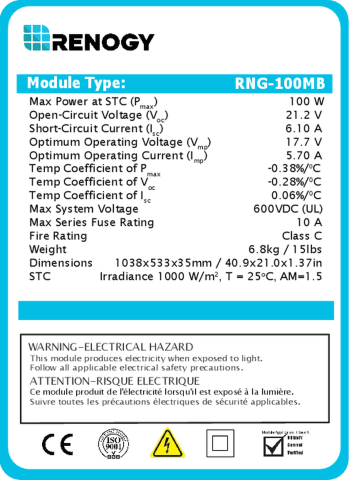 Example: Label attached to solar panels
Example: Label attached to solar panels
The amount of electrical energy generated by a solar module depends mainly on:
Daily radiant flux density: The amount of energy provided by the sun in one day is the most important factor. Areas near the equator have the best average radiant flux density, but this general rule can vary greatly from place to place and from season to season. The average performance of a PV system expressed in kWh/m2/day can be indicated in the chart below.
Shade, fog, cloudy weather: Any obstacle that blocks sunlight will reduce the power output of the unit. Additionally, if a solar panel is partially shaded, electricity production may stop because the shaded cells will consume the energy produced by the rest of the panel. In some cases, a phenomenon called “hot spot heating” occurs when shaded parts of one panel heat up quickly because they draw electricity from an unshaded part, and this can lead to rapid destruction of the panel. This can be prevented by using bypass diodes that are usually included in PV modules, but it is highly recommended to check this feature.
Plate Orientation: A poorly oriented panel – for example, facing north in the Northern Hemisphere – will produce much less power than the panel’s rated power, or even no power at all.
Temperature: Temperatures above 25°C can also reduce the amount of energy produced by solar panels.
Daylight hours: Solar panels produce more electricity when the sun’s vertical rays are closer together, providing more energy per square centimeter. As a result, solar panels will produce less electricity when the sun is near the horizon than when the sun’s rays are directly overhead. In practice, a near-equator solar panel installed outdoors for 12 hours a day will only generate the equivalent of 6 hours of peak electricity, and that’s only under optimal conditions. Changes in seasons or bad weather will further reduce this production.
As a result of the above factors, it may be difficult to evaluate the actual electricity production of a solar system. One simple method is to size an installation so that it produces 30% of daily energy needs during the month when conditions are bad.
Installation of panels and arrays
It is possible to combine PV modules to create solar panels, as well as combine and mount solar panels together to create solar arrays using standard junction boxes – MC3/MC4 type – that are waterproof and easy to connect. As with batteries, panel arrays should only use solar modules that have the same characteristics, the same model, and the same history as much as possible.
Pregnant women
Solar trackers — devices that point panels toward the sun — are complex, expensive and not recommended outside industrial uses and/or high latitudes where the sun moves greatly. Some mounts are designed to allow seasonal adjustment, giving the ability to manually switch between two positions during the year, which should be more than enough for most installations.
There are two basic types of solar mounts available: ground and roof mounts. Ground-mounted solar panels are easier to install and maintain than roof-mounted systems. Roof-mounted systems are difficult or impossible to modify and can cause structural damage due to weight and wind pressure. However, floor stands have their own problems; They take up usable space, are more exposed to shade, and are also at risk of accidental damage from cars and people. Installation decisions should be made based on the location and available infrastructure.
Battery systems
Solar batteries are absolutely essential to help keep solar energy systems running. Without battery storage, electricity would only be available while the solar panels are producing it. Since panels only produce energy during the day while consumption may occur at any time, having a stable power bank is essential to store this energy. Please refer to the Batteries section for more information.
Solar regulator
Charger controllers, commonly known as solar regulators, are electronic units designed to control the flow of current – both the current that charges the batteries from the panels, and the current from the batteries to the offices/collectors.
Solar regulators control the charging and discharging of batteries by disconnecting the panels when the batteries are fully charged, and by cutting off power to the load when the battery is too low. Another important function of solar regulators is to improve the power output of panels by converting the high voltage output from the panels to the lower input voltage needed by the batteries. The regulator acts as the hub of the installation, and obtaining maximum power output depends on its proper functioning.
There are two types of solar regulators:
Maximum Power Point Tracking ( MPPT ): |
|
|---|---|
| Maximum Power Point Tracking ( MPPT ) detects the solar panel’s output voltage and current in real-time, continuously tracks the maximum power ( P=U*I ), and regulates the output voltage correspondingly so that the system can always charge the battery at maximum power. This type of energy tracking allows for better energy production under cloud cover and changing temperatures. Although initially more expensive, a MPPT charge controller will give more power (and possibly reduce the size of the PV module) and extend the life of the batteries connected to it. Some controllers even allow connection to smart devices for remote control and monitoring. | |
| Shipping Method | Multi-stage Maximum Power Point Tracking ( MPPT ). |
| Conversion rate of solar energy into electricity | 99% |
| Ampere rate | 30A-100A |
| Scalability/range | >2 kW large power system |
| Average price | $120 |
| Advantages |
|
| Defects |
|
Pulse Width Modulation ( PWM ): |
|
|---|---|
| Pulse width modulation (PWM) charge controllers can be thought of as a switch between solar panels and battery packs, and are programmed to allow only a pre-set current to pass into the battery. The controller slowly reduces the amount of power entering the battery as the batteries approach maximum capacity. Pulse-width modulation (PWM) charge controllers do not adjust voltage, which means that batteries and panels must have compatible voltages in order to work properly. This makes this type of charge controller suitable for simple solar applications, or for installations featuring lower voltage panels and battery packs of limited size. Pulse width modulation (PWM) is an affordable option but will produce less power than PV. | |
| Shipping Method | Pulse width modulation ( PWM ) stages |
| Conversion rate of solar energy into electricity | 75%-80% |
| Ampere rate | 20A – 60A |
| Scalability/range | <2 kW small solar system |
| Average price | $65 |
| Advantages |
|
| Defects |
|
Installation of panels
The storage location for the batteries connected to the solar array must be determined before any equipment can be sized and purchased. Not only is it necessary that the space be large enough to install the required panels, but the distance and cable length from the battery storage location will also affect the calculated power requirements. Please refer to the section on battery installation .
A good location to install a solar array will have the following characteristics:
- It must be inside a complex and not visible from the outside. Ground-mounted solar panels must be protected by a wall or fence, so it is important to have sufficient ground space.
- To be as close as possible to the battery system.
- Be away from shade, such as trees or buildings.
Sometimes, it’s difficult to completely avoid shaded areas. The priority should be to avoid shade during the sunny hours of the day (generally from 10:00 to 16:00). Remember that the position and size of shadows change with the seasons.
Location of solar panels
To optimize energy production, solar panels must be carefully oriented to make the most of sunlight exposure. Reference to solar panels includes the following.
- Direction – Direction is the angle of the solar panel relative to the north-south axis. Solar panels should face south in the Northern Hemisphere and north in the Southern Hemisphere.
- Tilt – Tilt is the angle of the solar panel relative to the horizontal. Improving tilt is more difficult. The latitude can be used as an approximation of the optimal tilt angle, as indicated in the guide below for fixed angle panels. However, even at the equator, panels must have a minimum tilt angle of 5 to 10 degrees to avoid water and dust accumulating on the panel.
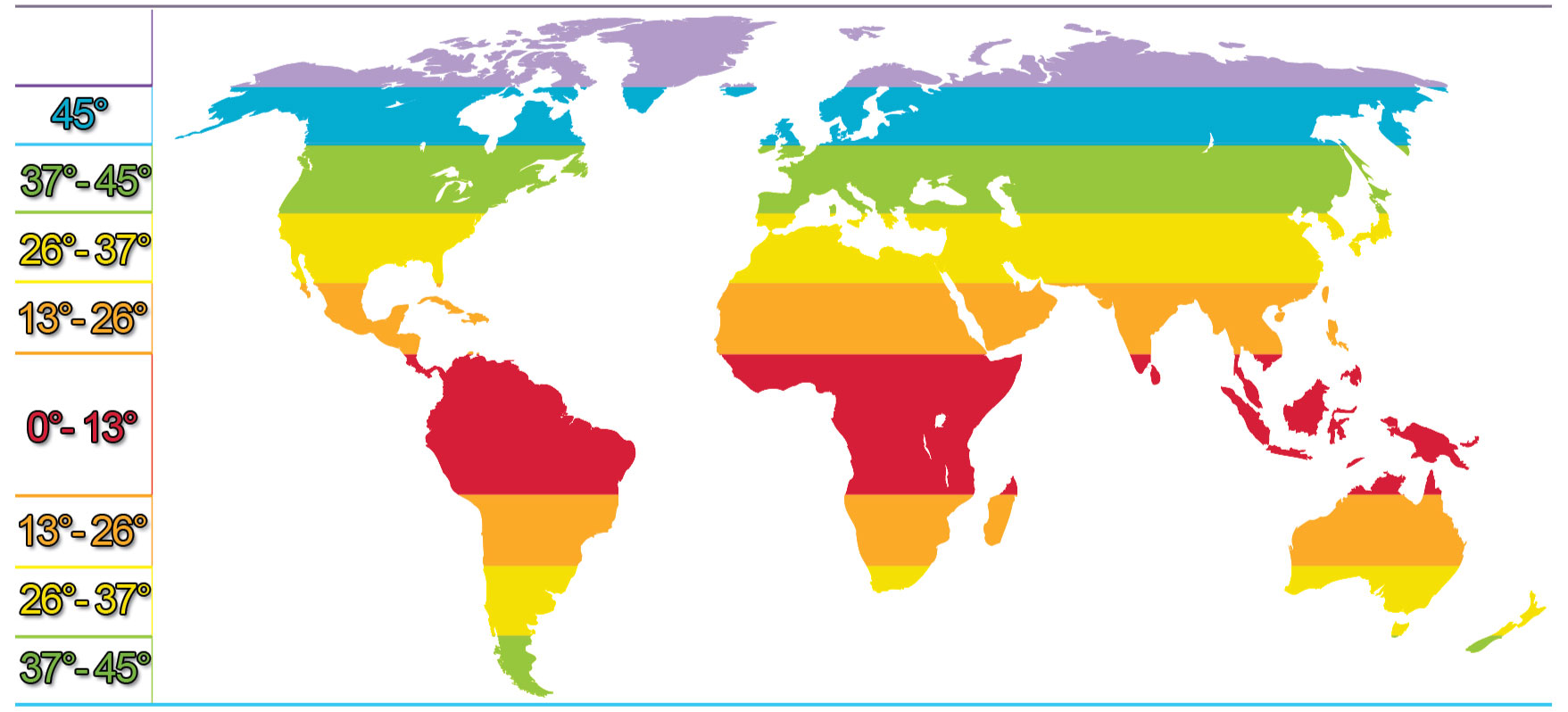
Delivery
The output of solar panels is connected to the solar regulator, while the output of the solar regulator is connected to the batteries. The solar panel mounting frame is connected to ground, and it is highly recommended to use a grounding/ground connection for the regulator and surge protector.
Panels can follow three different schemes, which will give different results in terms of power and current, depending on the capacity or power required. Units connected in series, parallel, or a combination of both will give different power and energy outputs.
Choose installation size
Photovoltaic modules
Here’s a simple way to size installations so they produce 30% of daily energy needs during the worst months of the year:
| Example: | To cover 30% of the installation’s energy needs, how many solar panels are needed for the following:
The actual total energy production required daily is:
12 . 88 x 0 . 3 = 3 . 87 kwh _ _ _ _ _ _ _ _ _ _ _ _ _ _
At an average daily production of 2.62 kWh per 1 kW peak of the unit, the total daily requirement is:
3 . 87/2 . _ _ 62 = 1 . 48 kWh 3.87 / 2.62 = 1.48 kW peak _ _ _
The actual number of solar panels required will depend on the peak power of each individual panel. The configuration may be:
Given an average annual daily production of 4.32 kWh per 1 kW peak, a 1.48 kW peak installation will produce 4.32 x 1.48 = 6.39 kWh per day in annual average, adding up to the total incremental energy cost savings. |
|---|
Organizer
The size of the solar regulator should be chosen according to the number and type of solar modules used. Organizer size includes:
- The voltage should be as high as possible depending on the number of solar modules in the systems.
- The maximum current should be equal to the short circuit current (ISC) of your solar array. The short circuit current for one individual panel can be found on the panel’s identification label or in the manufacturer’s manual. To calculate the short-circuit current for the entire array, sum the short-circuit currents of all panels connected in parallel.
Batteries
Information about battery sizes can be found in the section on Installing the Battery System.
Cables and protection
Information about cable lengths and wire gauges can be found in the Electrical Installations chapter.
Safety and security
Photovoltaic panels produce electricity just like regular generators. Although the production method may be different and, depending on the size of the array, the total electrical power is less than the generator, solar arrays can still produce harmful amounts of electricity.
Handling
When people have to handle solar PV panels, they should wear appropriate protective clothing and equipment at all times.
Most importantly – solar PV panels produce electrical current, even when they are not connected to any other device! As long as the panel is partially exposed to light, it will produce some form of current and can still pose a hazard. The panel that produces electricity will not emit any noise or vibration, and may not even be warm to the touch. Photovoltaic solar panels usually do not include any indication that they produce electricity at all. For this reason, solar PV panels appear safe to touch, even when they are not.
When installing, removing or simply modifying solar panels, they must be completely covered. Work can also be performed at night if possible. When carrying or handling solar panels, handlers should pay attention to all electrical connector outputs on the side, and avoid accidentally touching them. Pay attention to all wires coming out of a solar panel just like the electrical wires coming out of a power grid or generator.
Security
Solar PV panels should always be in a safe place, just like generators and batteries. The orientation of buildings and vegetation can make this a difficult task, but planners should consider access control.
- Install panels on rooftops, and in areas that people don’t visit frequently if possible – avoid rooftop terraces or rest areas.
- Install solar arrays within complex spaces, and within a secure perimeter wall where possible. Even if the arrays are within a compound wall, there should be some form of signage and barrier fencing to prevent visitors or temporary workers from entering the area.
- If the solar arrays are installed in open or remote locations, a separate security fence or wall will need to be built around the outside of the array. The equipment is expensive, but it can also harm humans and animals passing by. People unfamiliar with solar panels may approach out of curiosity, so signage should be in the appropriate local language.
If you have any inquiry, please contact us freely and we will be happy to serve you.

Jezli website for purchasing electrical appliances
When we say Jeezly website, we are talking about one of the most famous Arab websites that was able, in a very short period of time, to achieve a very large demand for purchases from it by people from various parts and sectors of the Arab world.
On the Jeezly website, you will find a joint look and all the products that you may need in your home, starting with those for kitchens or bathrooms, but even those for gardens, you will find them on this wonderful site.
So, if you were lost before and did not know where to go to buy your products on the Internet, now you have the perfect solution, and all you have to do is go to the Jezli website and start choosing the products you want.
 What are the features of Jeezly ?
What are the features of Jeezly ?
Since we are talking about a site that is preferred by many people around the world, there is no doubt that it is a site full of various features and characteristics. Therefore, we have decided to devote our next paragraph to pointing out the most prominent features of the Jezli site.
One of the most prominent features of the site is the proportionality of prices. On the Jeezly website, you do not have to worry about the imaginary prices of the products, as is the case with most sites that display their products on the Internet.
The price of delivering products is very reasonable and not expensive, and the site accepts delivery to various countries, without forgetting that it accepts free shipping on some products.
One of the features of the site is also the high quality of its products, as it is impossible to find a poor quality product. Rather, the Jezli website deals with the major companies, Philips, for example, and other famous brands, so you must remove from your mind the idea of the poor quality of one of the products. Another advantage of the site is that it does not specialize in one type of product, but rather you will find various types of products on it, for example, electrical appliances, hand tools, mechanical devices, paints, packages for establishing apartments, and many other types.
Jeezly website also accepts what is known as the shopping cart, which makes it easy for you to filter the products you want to buy and put them in one package in order to be able to pay with the click of a single button.
Accepts multiple payment methods.
We are pleased that you visit our social media pages, where we publish exclusive offers on our website.
Our Facebook page is here .
Our Twitter account is here .


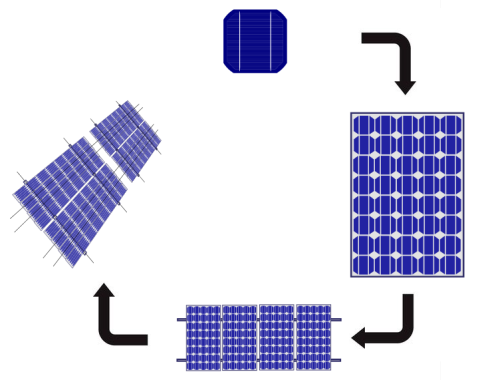

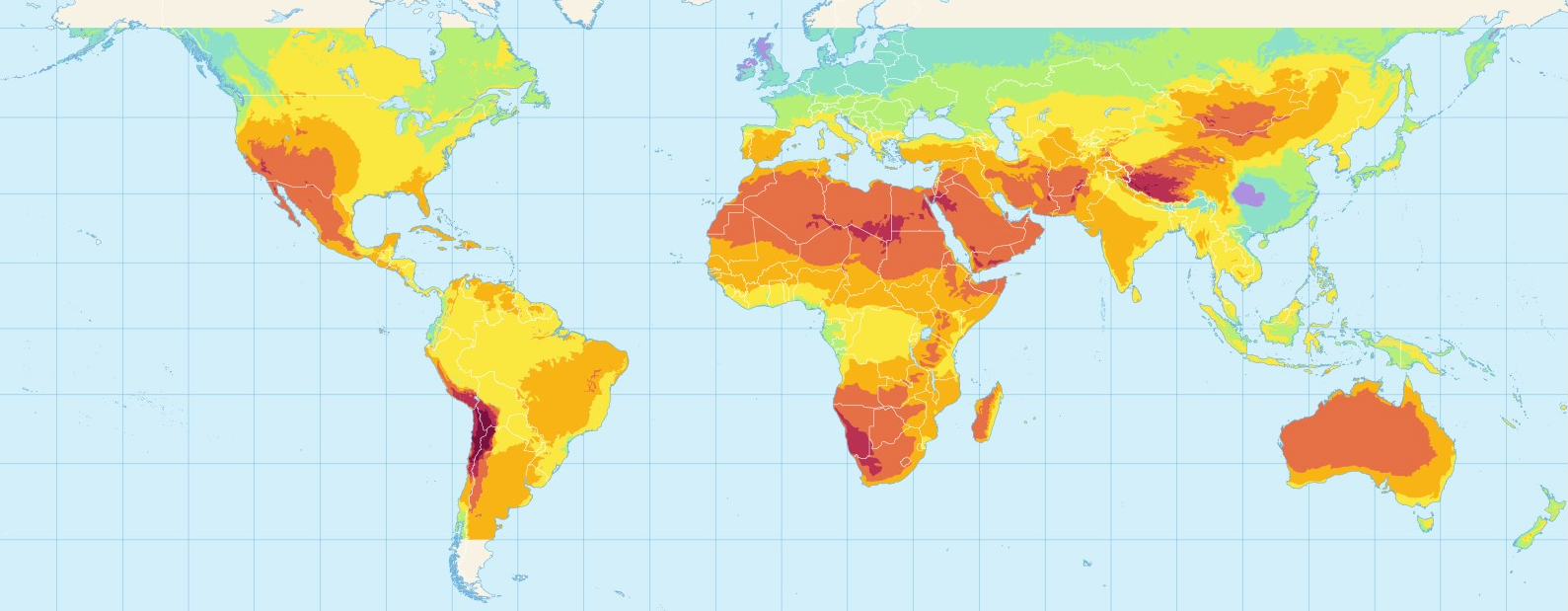
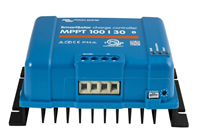
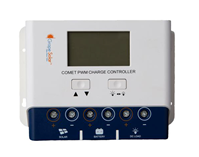


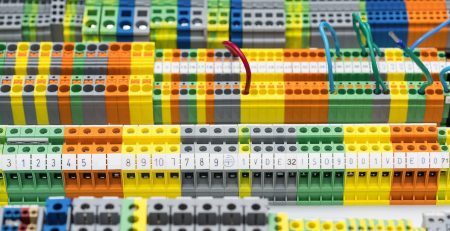
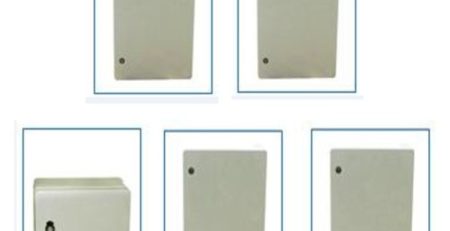
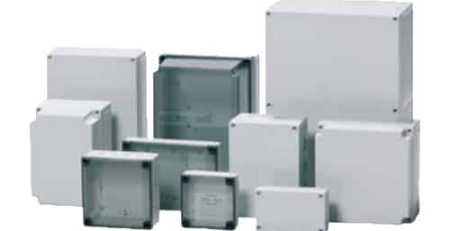
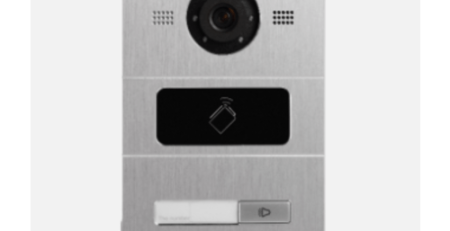





Leave a Reply
You must be logged in to post a comment.